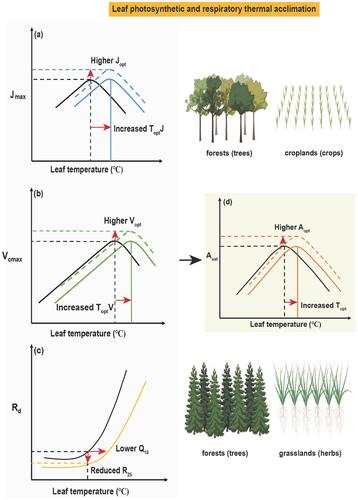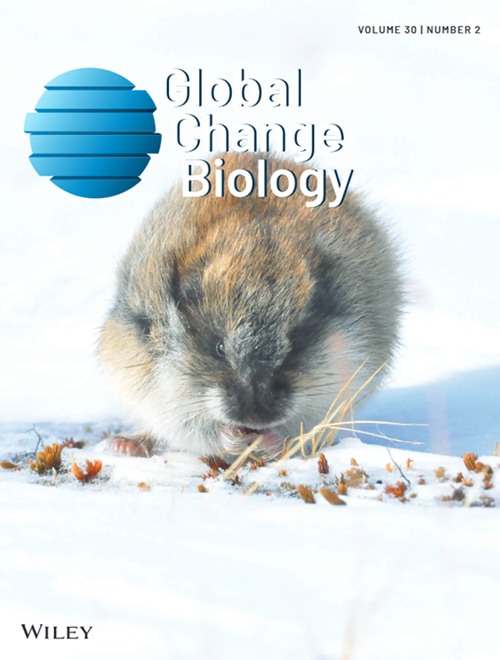陆生植物叶片光合和呼吸热驯化对全球变暖的响应
IF 10.8
1区 环境科学与生态学
Q1 BIODIVERSITY CONSERVATION
引用次数: 0
摘要
叶片光合作用和呼吸作用是大气和生物圈之间最大的两个碳通量。虽然研究变暖对光合和呼吸热适应的影响的实验已经广泛开展,但各种生态系统和植被类型对变暖的敏感性仍然不确定。在这里,我们对全球热驯化的实验观测进行了荟萃分析。研究发现,温度每升高1℃,热带森林植物光合速率(Topt)和Rubisco羧化速率(ToptV)的最适温度分别升高0.51℃和2.12℃。同样,温度每升高1℃,温带森林植物RuBP再生最大电子传递速率(ToptJ)的Topt和最适温度分别升高0.91℃和0.15℃。而热带森林和草地植物在最适温度下的光合速率(Aopt)分别为17.2%和16.5%,表明它们对变暖的光合热适应有限。气候变暖使北方森林植物的呼吸速率(R25)降低了6.2%,表明呼吸能够适应气候变暖。阔叶落叶乔木的光合作用和呼吸作用可以适应气候变暖,Aopt(7.5%)和Topt(1.08°C / 1°C)较高,R25(7.7%)较低。我们发现针叶常绿乔木(- 14.1%)和草本植物(- 16.3%)的光合热驯化有限,两者都与Aopt降低有关。适应变暖的针叶落叶乔木的呼吸作用(降低的R25和呼吸的温度敏感性(Q10));而阔叶常绿乔木不适应(R25升高)。草地植物和草本植物对气候变暖的光合适应最弱,主要是由于Aopt的显著减少。我们的全球综合研究全面分析了变暖对不同生态系统和植被类型热适应的不同影响,并为植被碳循环对变暖的响应提供了一个建模框架。本文章由计算机程序翻译,如有差异,请以英文原文为准。

Leaf Photosynthetic and Respiratory Thermal Acclimation in Terrestrial Plants in Response to Warming: A Global Synthesis
Leaf photosynthesis and respiration are two of the largest carbon fluxes between the atmosphere and biosphere. Although experiments examining the warming effects on photosynthetic and respiratory thermal acclimation have been widely conducted, the sensitivity of various ecosystem and vegetation types to warming remains uncertain. Here we conducted a meta‐analysis on experimental observations of thermal acclimation worldwide. We found that the optimum temperature for photosynthetic rate (T opt ) and the maximum rate of carboxylation of Rubisco (T opt V) in tropical forest plants increased by 0.51°C and 2.12°C per 1°C of warming, respectively. Similarly, T opt and the optimum temperature for maximum electron transport rate for RuBP regeneration (T opt J) in temperate forest plants increased by 0.91°C and 0.15°C per 1°C of warming, respectively. However, reduced photosynthetic rates at optimum temperature (A opt ) were observed in tropical forest (17.2%) and grassland (16.5%) plants, indicating that they exhibited limited photosynthetic thermal acclimation to warming. Warming reduced respiration rate (R 25 ) in boreal forest plants by 6.2%, suggesting that respiration can acclimate to warming. Photosynthesis and respiration of broadleaved deciduous trees may adapt to warming, as indicated by higher A opt (7.5%) and T opt (1.08°C per 1°C of warming), but lower R 25 (7.7%). We found limited photosynthetic thermal acclimation in needleleaved evergreen trees (−14.1%) and herbs (−16.3%), both associated with reduced A opt . Respiration of needleleaved deciduous trees acclimated to warming (reduced R 25 and temperature sensitivity of respiration (Q10 )); however, broadleaved evergreen trees did not acclimate (increased R 25 ). Plants in grasslands and herbaceous species displayed the weakest photosynthetic acclimation to warming, primarily due to the significant reductions in A opt . Our global synthesis provides a comprehensive analysis of the divergent effects of warming on thermal acclimation across ecosystem and vegetation types, and provides a framework for modeling responses of vegetation carbon cycling to warming.
求助全文
通过发布文献求助,成功后即可免费获取论文全文。
去求助
来源期刊

Global Change Biology
环境科学-环境科学
CiteScore
21.50
自引率
5.20%
发文量
497
审稿时长
3.3 months
期刊介绍:
Global Change Biology is an environmental change journal committed to shaping the future and addressing the world's most pressing challenges, including sustainability, climate change, environmental protection, food and water safety, and global health.
Dedicated to fostering a profound understanding of the impacts of global change on biological systems and offering innovative solutions, the journal publishes a diverse range of content, including primary research articles, technical advances, research reviews, reports, opinions, perspectives, commentaries, and letters. Starting with the 2024 volume, Global Change Biology will transition to an online-only format, enhancing accessibility and contributing to the evolution of scholarly communication.
 求助内容:
求助内容: 应助结果提醒方式:
应助结果提醒方式:


